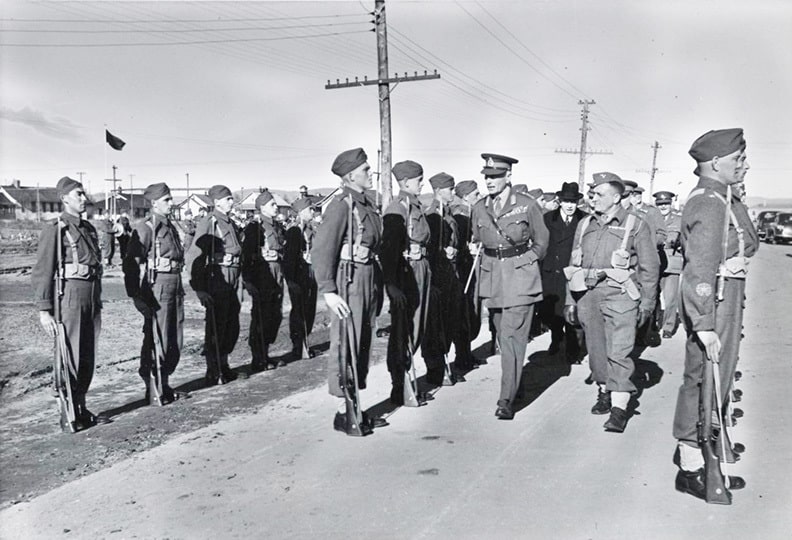
Official visit to Valcartier military base in Quebec City, Quebec, Canada, during the Second World War. The Governor-General, the Earl of Athlone, and the Prime Minister, William Lyon Mackenzie King, reviewing troops. King, the longest-serving Canadian prime minister in history is best known for his leadership of Canada throughout World War II when he mobilized Canadian money, supplies and volunteers to support Britain while boosting the economy and maintaining home front morale. For more details on his life, click this link.
By: Phil Kohn. Dedicated to the memory of his father, GM3 Walter Kohn, U.S. Navy Armed Guard, USNR, and all men and women who have answered the country’s call in time of need. Phil can be contacted at ww2remembered@yahoo.com.
In Ukraine, Soviet forces on August 20, 1943, capture Lebedyn, 107 miles northwest of Kharkiv. On Papua-New Guinea, Allied troops engage in heavy fighting southwest of Salamaua. In Asia, Japan and Thailand sign a peace treaty, which includes a provision that four Japanese-occupied provinces of the former British Malaya will be transferred to Thailand.
On August 21 in Washington, D.C., Andrei Gromyko takes over as the U.S.S.R.’s ambassador to the United States, replacing Maxim Litvinov. From Quebec City, Quebec, Canada, President Roosevelt and Canadian Prime Minister William Lyon Mackenzie King jointly announce that troops from the two countries have retaken Kiska Island in the Aleutians. The two say that announcement of the victory was delayed “for security reasons.”
With no reinforcements expected in the foreseeable future, the Japanese on August 22 evacuate the last of their soldiers on New Georgia Island to neighboring Kolombangara. In Ukraine, German troops begin to withdraw from Kharkiv.
The heaviest raid to date on Berlin is made on August 23, as 727 RAF bombers drop more than 1,700 tons of bombs on the German capital. The Red Army retakes Kharkiv, Ukraine. Japanese planes conduct air raids on the Nationalist Chinese capital of Chungking.
On August 24, a blanket of smoke covers Berlin to a height of 20,000 feet. The first estimates put German dead at 5,860 after the previous day’s air raid. Adolf Hitler names Reichsführer-SS Heinrich Himmler as Germany’s Reich Minister of the Interior. The Battle of the Dnieper begins as the Red Army launches an offensive to capture the east bank of the Dnieper River, which flows through Russia, Belorussia and Ukraine. The attack — involving 2.3 million Red Army troops and 1.25 million Germans — stretches across a front of 870 miles, from Smolensk, Russia, in the north to the Sea of Azov in the south.
U.S. forces complete the capture of New Georgia Island in the Solomons on August 25. British Royal Navy Vice Adm. Lord Louis Mountbatten is named Supreme Allied Commander of Southeast Asia. He will conduct war operations in concert with the Supreme Allied Commander of the Southwest Pacific, U.S. Army Gen. Douglas MacArthur.
U.S. bombers attack Hong Kong on August 26. The Soviet Union and Egypt establish diplomatic relations for the first time.


